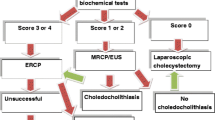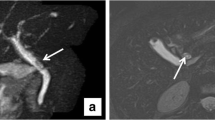Abstract
Acalculous biliary pain has been related to gallbladder dysfunction that produces a gallbladder emptying defect—a condition which favours the development of lithiasis. It is therefore probable that microlithiasis is present in patients with gallbladder dysfunction. The aims of this study were to measure gallbladder emptying and investigate bile abnormalities in patients with acalculous biliary pain. In 92 consecutive patients, gallbladder emptying was assessed by quantitative cholescintigraphy (abnormal ejection fraction ≤40%). In 64 patients, a microscopic study was performed on duodenal bile, defining abnormality as the presence of cholesterol crystals in any amount and/or calcium bilirubinate granules and/or microspheroliths at a rate of >10 per slide. The ejection fraction was abnormal in 45 patients (49%) (median 25.1%, range 6.8–39.3%) and normal in the remaining 47 cases (median 71.3%, range 41.0–96.1%). Bile was abnormal in 32 of 64 patients (50%), the most frequent finding being calcium bilirubinate granules. In the patients with bile abnormalities, abnormal ejection fraction was more frequent (20 of 32) and the median ejection fraction was lower (30.9%, range 12.0–94.1%) than in the patients with normal bile (16 of 32 with an abnormal ejection fraction; median ejection fraction 50.7%, range 6.8–96.1%). Abnormal bile was frequent (55.5%) in patients with reduced ejection fraction, but was not uncommon in patients with normal ejection fraction (33.3%). Fewer patients showed no alteration (25%). It is concluded that in most patients, acalculous biliary pain coexists with gallbladder dysfunction or abnormal bile, the combination of both alterations being common.
Similar content being viewed by others
References
Drossman DA, Talley NJ, Thompson WG, et al., eds. The functional gastrointestinal disorders, 2nd edn. McLean, VA: Degnon Associates; 2000:433–481.
Freeman JB, Cohen WN, DenBesten L. Cholecystokinin cholangiography and analysis of duodenal bile in the investigation of pain in the right upper quadrant of the abdomen without gallstones. Surg Gynecol Obstet 1975; 140:371–376.
Houssin D, Castaing D, Lemoine J, Bismuth H. Microlithiasis of the gallbladder. Surg Gynecol Obstet 1983; 157:20–24.
Moskovitz M, Min TC, Gavaler JS. The microscopic examination of bile in patients with biliary pain and negative imaging tests. Am J Gastroenterol 1986; 81:329–333.
Yap L, Wycherley AG, Morphett AD, Toouli J. Acalculous biliary pain: cholecystectomy alleviates symptoms in patients with abnormal cholescintigraphy. Gastroenterology 1991; 101:786–793.
Yost F, Margenthaler J, Presti M, Burton F, Murayama K. Cholecystectomy is an effective treatment for biliary dyskinesia. Am J Surg 1999; 178:462–465.
Misra DC Jr, Blossom GB, Fink-Bennett D, Glover JL. Results of surgical therapy for biliary dyskinesia. Arch Surg 1991; 126:957–960.
Pitt HA, Doty JE, DenBesten L, Kuchenbecker SL. Stasis before gallstone formation: altered gallbladder compliance or cystic duct resistance? Am J Surg 1982; 143:144–149.
Brugge WR, Brand DL, Atkins HL, Lane BP, Abel WG. Gallbladder dyskinesia in chronic acalculous cholecystitis. Dig Dis Sci 1986; 31:461–467.
Burnstein MJ, Vassal KP, Strasberg SM. Results of combined biliary drainage and cholecystokinin cholecystography in 81 patients with normal oral cholecystograms. Ann Surg 1982; 196:627–632.
Pons V, Sopena R, Hoyos M, Garrigues V, Cano C, Nos P, Ponce J. Quantitative cholescintigraphy. Selection of random dose for CCK-33 and reproducibility of abnormal results. J Nucl Med 2003; 44:446–450.
Zech ER, Simmons LB, Kendrick RR, Soballe PW, Olcese JA, Goff WB 2nd, Lawrence DP, DeWeese RA. Cholecystokinin enhanced hepatobiliary scanning with ejection fraction calculation as an indicator of disease of the gallbladder. Surg Gynecol Obstet 1991; 172:21–24.
Vezina WC, Paradis RL, Grace DM, Zimmer RA, Lamont DD, Rycroft KM, King ME, Hutton LC, Chey WY. Increased volume and decreased emptying of the gallbladder in large (morbidly obese, tall normal, and muscular normal) people. Gastroenterology 1990; 98:1000–1007.
Fink-Bennett D, DeRidder P, Kolozsi W, Gordon R, Rapp J. Cholecystokinin cholescintigraphic findings in the cystic duct syndrome. J Nucl Med 1985; 26:1123–1128.
Upp JR Jr, Nealon WH, Singh P, Fagan CJ, Jonas AS, Greeley GH Jr, Thompson JC. Correlation of cholecystokinin receptors with gallbladder contractility in patients with gallstones. Ann Surg 1987; 205:641–648.
Wegstapel H, Bird NC, Chess-Williams R, Johnson AG. The relationship between in vivo emptying of the gallbladder, biliary pain, and in vitro contractility of the gallbladder in patients with gallstones: is biliary colic muscular in origin? Scand J Gastroenterol 1999; 34:421–425.
Corazziari E, Biondi M. Dysfunctional disorders of the biliary tract. Semin Gastrointest Dis 1996; 7:196–207.
Bouin M, Plourde V, Boivin M, Riberdy M, Lupien F, Laganiere M, Verrier P, Poitras P. Rectal distention testing in patients with irritable bowel syndrome: sensitivity, specificity, and predictive values of pain sensory thresholds. Gastroenterology 2002; 122:1771–1777.
Humphries TJ, Cloutier CT. The value of duodenal bile examination in the evaluation of persistent pain in the upper part of the abdomen. Surg Gynecol Obstet 1978; 147:177–181.
Kato I, Nomura A, Stemmermann GN, Chyou PH. Prospective study of clinical gallbladder disease and its association with obesity, physical activity, and other factors. Dig Dis Sci 1992; 37:784–790.
Portincasa P, Di Ciaula A, Vendemiale G, Palmieri V, Moschetta A, Vanberge-Henegouwen GP, Palasciano G. Gallbladder motility and cholesterol crystallization in bile from patients with pigment and cholesterol gallstones. Eur J Clin Invest 2000; 30:317–324.
Velanovich V. Biliary dyskinesia and biliary crystals: a prospective study. Am Surg 1997; 63:69–74.
Sharma BC, Agarwal DK, Dhiman RK, Baijal SS, Choudhuri G, Saraswat VA. Bile lithogenicity and gallbladder emptying in patients with microlithiasis: effect of bile acid therapy. Gastroenterology 1998; 115:124–128.
Pons V, Ballesta A, Ponce M, Maroto N, Arguello L, Sopena R, Garrigues V, Ponce J. Dynamic ultrasonography in the diagnosis of gallbladder dysfunction: reliability of a simple method with easy clinical application. Gastroenterol Hepatol 2003; 26:8–12.
Acknowledgements
This work was supported by a grant from the Fondo de Investigaciones Sanitarias (FIS 96/1711), and also by a grant from the Instituto de Salud Carlos III (c03/02).
Author information
Authors and Affiliations
Corresponding author
Rights and permissions
About this article
Cite this article
Ponce, J., Pons, V., Sopena, R. et al. Quantitative cholescintigraphy and bile abnormalities in patients with acalculous biliary pain. Eur J Nucl Med Mol Imaging 31, 1160–1165 (2004). https://doi.org/10.1007/s00259-004-1464-6
Received:
Accepted:
Published:
Issue Date:
DOI: https://doi.org/10.1007/s00259-004-1464-6




